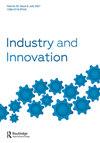门和墙:物理障碍和知识共享
IF 4.2
3区 管理学
Q1 ECONOMICS
引用次数: 0
摘要
现有文献表明,即使在同一栋建筑内,物理距离也会对知识共享产生负面影响。此外,物理障碍(如门和墙)的影响已被标记为研究的重要途径。我们通过揭示物理障碍对知识共享的影响以及这种关系的调节因素,为微观地理文献做出了贡献。基于个体企业员工知识共享的微观观察数据,我们发现在考虑距离因素后,物理障碍阻碍了知识共享。同时,我们对物理障碍与二元和个人层面的知识共享之间的负相关关系的几个调节因素进行了理论推导并找到了证据:强联系、参与跨部门协调机制、工作自主权和办公室位置靠近打印室。该研究对负责办公室分配和办公室物理布局的管理人员具有启示意义。本文章由计算机程序翻译,如有差异,请以英文原文为准。
Doors and walls: physical barriers and knowledge sharing
ABSTRACT The extant literature has demonstrated that physical distance negatively affects knowledge sharing, even within the same building. Moreover, the impact of physical barriers, such as doors and walls, has been flagged as an important avenue for research. We contribute to the micro-geography literature by unpacking the effects of physical barriers on knowledge sharing and moderators of that relationship. Based on micro-level, single-firm observational data on employees’ knowledge-sharing dyads, we find that physical barriers impede knowledge sharing after accounting for distance. Simultaneously, we theorise on and find evidence of several moderators of the negative relationship between physical barriers and knowledge sharing at the dyadic and individual levels: strong ties, participation in coordination mechanisms across departments, job autonomy, and location in an office near a printer room. The study has implications for managers in charge of office allocation and the physical layout of offices.
求助全文
通过发布文献求助,成功后即可免费获取论文全文。
去求助
来源期刊

Industry and Innovation
Multiple-
CiteScore
8.10
自引率
7.70%
发文量
41
期刊介绍:
Industry and Innovation is an international refereed journal presenting high-quality original scholarship of the dynamics of industries and innovation. Interdisciplinary in nature, Industry and Innovation is informed by, and contributes in turn to, advancing the theoretical frontier within economics, organization theory, and economic geography. Theoretical issues encompass: •What are the institutional underpinnings for different organizational forms? •How are different industrial structures and institutions related to innovation patterns and economic performance?
 求助内容:
求助内容: 应助结果提醒方式:
应助结果提醒方式:


